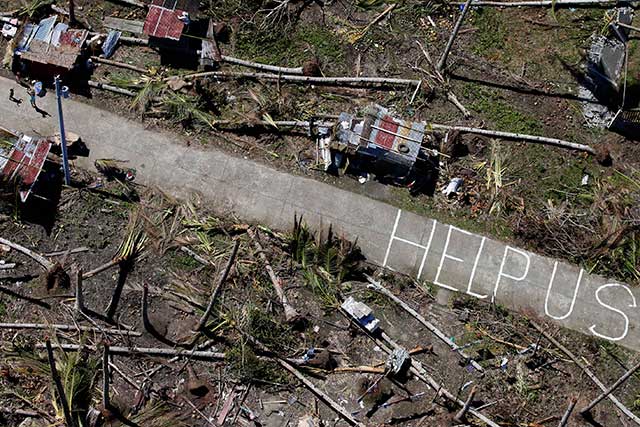SUMMARY
This is AI generated summarization, which may have errors. For context, always refer to the full article.

MANILA, Philippines – The total cost of damage wrought by Super Typhoon Yolanda (Haiyan) has risen to P9.46 billion.
In its November 16 morning update, the National Disaster Risk Reduction and Management Council (NDRRMC) said P9.09 billion of this accounts for agricultural losses. Damage to infrastructure now amounts to more than P371 million.
At the same time, a week after Yolanda devastated parts of the Visayas, the count of the dead has slowed down.
Twelve hours after its last update, the NDRRMC added only 12 casualties to its last count. From a deathtoll of 3,621 in its November 15, 8 pm update, the number of casualties stands at 3,633 as of 8 am of Saturday, November 16. This means there was an average casualty count of only one every hour.
The rate is significantly slower than past counts. The November 15 evening update added 1,271 recorded casualties to its morning update.
The United Nations Office for the Coordination of Humanitarian Affairs says the number of people affected has risen to 12.9 million, with over 1.9 million people displaced.
Crop, livelihood losses
The losses from Yolanda, said to be the strongest storm to make landfall were reported from the following regions: Calabarzon, Mimaropa, Bicol, Western Visayas, Eastern Visayas, Central Visayas and Caraga.
Rice was the hardest hit crop. A total of 155,366 hectares of land planted with rice was affected. The council pegged production loss at P7.7 billion.
Corn crops were also affected after 86,192 hectares of corn-planted land was damaged.
The P1.3 billion worth of damages to livestock, fisheries and irrigation facilities is a big blow to many of the affected localities which largely depend on fishing and farming as a source of livelihood.
The United Nations said the Philippines will need US$301 million (P13.1 billion) to rehabilitate and recover from the disaster. So far, 40 foreign governments and 21 international groups have pledged aid. See the list here.
Meanwhile, 1,179 are still missing and 12,487 people are reported injured.
Below is the breakdown:
Total deaths: 3,633
- Calabarzon – 2
- Mimaropa – 5
- Bicol – 5
- Western Visayas – 113
- Central Visayas – 74
- Eastern Visayas – 3,432
- Zamboanga Peninsula – 1
- Caraga – 1
Injured: 12,487
- Calabarzon – 2
- Bicol – 21
- Western Visayas – 171
- Central Visayas – 102
- Eastern Visayas – 12,190
- Zamboanga Peninsula – 1
Missing: 1,179
- Western Visayas – 11
- Central Visayas – 5
- Eastern Visayas – 1,163
Earlier, President Benigno Aquino III downplayed early estimates by local officials of 10,000 dead. He said the number was most likely between 2,000 and 2,500 only. On Friday, a police general who claimed 10,000 people might have been killed was relieved from his position.
Aid needed, problems faced
The 1.9 million displaced are now being served inside and outside evacuation centers. A total of 422,290 are inside 1,142 evacuation centers.
These evacuation centers depend on a steady stream of relief goods to provide basic needs to refugees on a day-to-day basis. In Eastern Samar, Guiuan town airport is being used as a hub for relief goods. For the affected areas in northern Cebu, the hub is Cebu City. In Leyte, relief goods are being sent to airports in hubs like Tacloban City and Ormoc.
Towns serviced by the Tacloban hub include the ff:
Abuyog, Alang-alang, Babatngon, Barugo, Burauen, Capoocan, Carigara, Dagami, Dulag, Jaro, Javier, Julita, Lapaz, Macarthur, Mahaplag, Mayorga, Palo, Pastrana, San Miguel, Sante Fe, Tabon-tabon, Tanauan, Tolosa, Tunga.
Towns served by the Ormoc hub are:
Albuera, Bato, Calubian, Hilongos, Hindang, Inupacan, Isabel, Kananga, Matag-ob, Matalom, Merida, Palompon, San Isidro, Tabango, Villaba, Baybay, Ormoc City.
While all airports under the Civil Aviation Authority of the Philippines (CAAP) are operational, the operation of Tacloban Airport remains limited. However, all roads and bridges previously blocked by debris or damaged are now passable.
A total of P85.3 billion worth of aid was provided to affected localities in Visayas, Calabarzon, Mimaropa, Northern Mindanao and the Davao region. To know how you can help in relief efforts, click here.
Entire provinces and several towns still remain off the grid. They are as follows:
- Biliran, Leyte, Southern Leyte, Northern Samar, and Eastern Samar
- Palawan (4 towns unrestored)
- Mindoro (1 town unrestored)
- Masbate (4 towns unrestored)
- Aklan (18 towns unrestored)
- Antique (7 towns unrestored)
- Capiz (21 towns unrestored)
- Iloilo (15 towns unrestored)
- Negros Occidental (6 towns unrestored)
- Cebu (14 towns unrestored)
- Bohol (37 towns unrestored)
Smart and Sun signals have been completely restored in Cebu, Bohol, Iloilo, Guimaras and Negros Oriental.
But in Eastern Samar, one of the worst-hit areas, only 14% of municipalities have cellular phone signals (Smart and Sun). In Leyte, 53% of municipalities can communicate using Smart and Sun networks, while only 9% can use the Globe network.
World media criticized the Aquino government for its seemingly slow and disorganized execution of relief operations. Faced with the herculean task of rebuilding 44 devastated provinces, Aquino called on all Filipinos to volunteer and assist in relief efforts. – Rappler.com
Add a comment
How does this make you feel?
There are no comments yet. Add your comment to start the conversation.